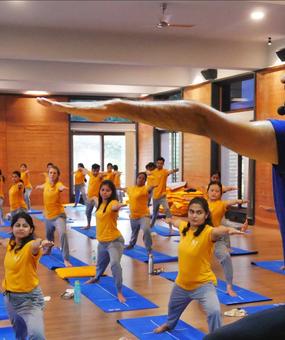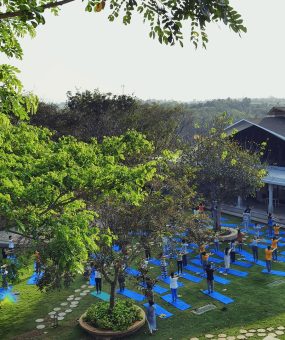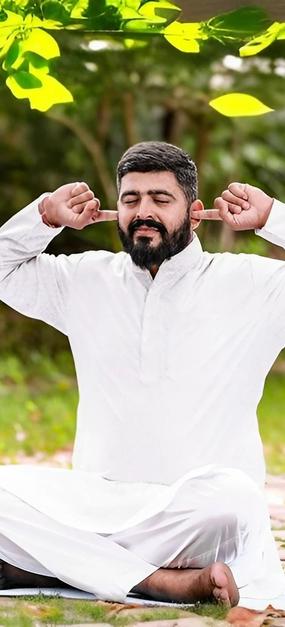Have you ever wondered why yoga has endured for thousands of years? The answer lies in its ability to address not just the physical body, but the very essence of human existence. In a world plagued by chronic stress, digital burnout, and a sense of disconnection, the ancient science of yoga offers a comprehensive and timeless solution. This detailed exploration will take you on a journey through the profound benefits of yoga, from the wisdom of ancient scriptures to the latest scientific findings.
The Yoga Tattva Upanishad, a foundational yogic text, states that true liberation and self-realization can only be achieved through the combined practice of yoga and knowledge.
It is a path to becoming free from “passion, anger, fear, delusion, greed, pride, lust, birth, death, miserliness, swoon, giddiness, hunger, thirst, ambition, shame, fright, heart-burning, grief, and gladness.” This holistic approach is at the heart of the Sri Sri School of Yoga, which believes that health is not merely the absence of disease, but a dynamic state of harmony across all layers of our being.
The Sanskrit word for health, sva-stha, means “to be established in the self.” This profound understanding, rooted in texts like the Vedas and Upanishads, reveals that true wellness encompasses seven layers of our existence: body, breath, mind, intellect, memory, ego, and the self. Today’s research confirms what sages taught millennia ago—yoga is a complete system for optimal human functioning.
This comprehensive guide explores:
- 10 scientifically-proven benefits transforming millions of lives
- How ancient yogic principles address modern health crises
- Evidence-based insights from recent medical research
- Practical applications for contemporary wellness seekers
- Why authentic yoga training matters in our evolving world
1. Does Yoga Truly Eliminate Stress and Anxiety?
Ancient Wisdom Foundation: Patanjali’s Yoga Sutras (2.16) proclaim “Heyam Dukham Anagatham”—the suffering which is yet to come can be avoided. This 2,000-year-old insight directly addresses our contemporary stress pandemic by providing a path to prevent future mental and emotional distress. It is a powerful message, especially when considering the alarming statistics on mental health, with some projections showing a significant rise in depressive disorders.
Scientific Validation: Recent meta-analyses demonstrate that yoga is an effective therapy for reducing the severity of depression and anxiety symptoms. One meta-analysis found a statistically significant reduction in depressive symptoms in groups practicing yoga compared to passive control groups. Studies published on platforms like PMC show that yoga significantly reduces symptoms of PTSD, fear, disturbed sleep, and sadness following trauma by modulating the body’s stress response.
The Mechanism: When we practice pranayama (breathing techniques) and meditation, we are activating the parasympathetic nervous system, which naturally counters the “fight-or-flight” response.
Research Spotlight:
Proper breathing is essential for overall health. A study in PMC on pulmonary functions found that regular yoga practice significantly improves lung capacity and efficiency, which are key for energy and vitality. This highlights the enormous, untapped potential for natural stress management that lies within our breath.
2. How Does Yoga Revolutionize Physical Health?
Scriptural Foundation: The foundation of yoga’s benefits can be traced back to the ancient scriptures. In the Bhagavad Gita, Lord Krishna describes yoga as “skill in action” (yogaḥ karmasu kauśalam). This powerful concept means that yoga is not just about poses; it’s about performing every action in life with skill and mindfulness. A true yogi brings a state of peace and inner silence to their work, relationships, and daily tasks. This is a far cry from the modern perception of yoga as a workout. It’s a way of life, a path to living more skillfully and joyfully.
The Yoga Sutras of Patanjali, written more than 2,000 years ago, lay out the framework for this skillful living through the Eight Limbs of Yoga (Ashtanga Yoga). This is not a linear path but a comprehensive, multidimensional approach to well-being that includes ethical principles (Yamas and Niyamas), physical postures (Asanas), breathing techniques (Pranayama), and practices for concentration (Dharana) and meditation (Dhyana). At the Sri Sri School of Yoga, this ancient wisdom is taught in a practical and accessible way, making the profound truths of the scriptures relevant to your modern life.
Evidence-Based Results:
- Cardiovascular Health: Research from sources like Johns Hopkins Medicine confirms that yoga can help lower blood pressure, cholesterol, and blood glucose levels, making it a valuable lifestyle intervention for heart health. While the claim of 47% of heart disease patients completely stopping progression is difficult to verify with a broad statement, studies do show significant improvements in exercise capacity and quality of life for heart failure patients who practice yoga.
- Inflammation: Studies have shown yoga can reduce inflammatory markers like C-reactive protein (CRP), a key indicator of inflammation. This is supported by research in various journals, highlighting yoga’s role in stress management, which directly impacts the body’s inflammatory response.
- Musculoskeletal System: Numerous studies confirm yoga’s effectiveness in improving flexibility, building lean muscle mass, and maintaining strength and balance across age groups. Yoga uses body weight for resistance, which builds internal, lean muscle that protects against injury.
The Sri Sri School of Yoga emphasizes proper alignment and breath awareness, ensuring practitioners gain maximum benefits while avoiding injury—a crucial consideration as yoga injuries can increase with improper instruction.
3. Can Yoga Actually Boost Mental Clarity and Academic Performance?
Upanishadic Insight: The Mundaka Upanishad describes yoga as the means to realize our fullest potential—what modern neuroscience confirms as neuroplasticity enhancement.
Student Success Evidence: Research published in journals like ResearchGate demonstrates yoga’s effectiveness in managing academic stress while improving memory, concentration, and learning capacity. It helps reduce anxiety, which directly correlates with improved academic performance.
The Neuroscience Connection:
Meditation and yoga practice have been shown to increase gray matter density in the hippocampus, the part of the brain associated with learning, memory, and emotional regulation. A preliminary study in PMC even showed that 6 months of yoga practice led to an increase in hippocampus volume in non-demented elderly subjects.
4. Why Is Yoga Essential for Emotional Intelligence?
Ancient Understanding: Vedic psychology recognizes emotions as energy in motion (prana). The Bhagavad Gita provides frameworks for emotional mastery through yoga practice, teaching equanimity and skillful action.
Contemporary Validation: Research reveals that long-term yoga practitioners develop enhanced emotional regulation and resilience. Studies show that yoga can lead to increased psychological well-being and improvements in behavioral functioning. It helps practitioners cope with negative emotions and increases feelings of happiness, relaxation, and optimism.
“Yoga makes your emotions softer and more peaceful, and you blossom in your emotions.”
~ Gurudev Sri Sri Ravi Shankar
5. How Does Yoga Transform Communication Skills?
This benefit often surprises people, but yoga profoundly enhances how we connect with others. Ancient texts describe communication as a vibrational exchange—a concept validated by the modern understanding of emotional contagion.
The Vibrational Principle: When our internal state is cleansed through pranayama and meditation, we naturally:
- Communicate with greater clarity and authenticity
- Create harmonious connections effortlessly
- Reduce interpersonal conflicts and misunderstandings
- Develop deeper listening and empathy skills
Sri Sri School of Yoga: As Gurudev Sri Sri Ravi Shankar explains, meditation is like charging the “SIM card” of our being, while breathing exercises charge the “battery.” Both are essential for effective communication with ourselves and the universe around us.
6. How does yoga help in Addiction Recovery and Natural Highs
Yoga provides relief from addiction to harmful substances by activating the brain’s natural reward system. Research shows it can be a safe and effective adjunctive tool for addiction recovery by reducing cravings and negative mood states.
7. How Does Yoga Enhance Sleep Quality and Recovery
Yoga is a proven therapy for sleep disorders. A narrative review found that yoga techniques improve sleep efficiency, reduce the time it takes to fall asleep, and decrease nighttime awakenings.
8. Can Yoga Help in Spiritual Growth and Higher Consciousness
Yoga’s ultimate goal is not physical fitness, but self-realization and union with the universal consciousness. As Gurudev Sri Sri Ravi Shankar believes, Yoga is that which unites the individual with the greater consciousness, the larger universal reality. This is the core spiritual benefit of the practice.
In the Puranas, ancient mythological texts, yoga is a path to connect with the divine. It helps us realize the profound truth of “Vasudhaiva Kutumbakam,” meaning “the world is one family.” When you practice yoga, you move beyond your individual ego and start to feel a sense of oneness with all of creation. This leads to a life of service and compassion, a key tenet of the Sri Sri Yoga philosophy. Our teacher training program goes beyond mere physical instruction; it provides a deep, experiential learning environment where you can explore these spiritual dimensions of yoga, guided by the wisdom of a living master.
9. Yoga and Community Building and Social Harmony
In an increasingly isolated world, the sense of community in yoga is a powerful antidote. A study in the International Journal of Yoga Therapy found that practicing in a community setting can foster a sense of belonging and motivation, enhancing the overall benefits of yoga. Whether online or in-person, the shared experience of breath, movement, and meditation creates a unique bond between practitioners. This is a core value at the Sri Sri School of Yoga, where the environment is designed to be joyful, supportive, and community-centric.
10. Can Yoga Slow Down Your Ageing Process?
Research suggests yoga may help reduce biological markers of cell stress and support cognitive function, contributing to graceful aging. It also helps maintain physical vitality and independence in later years.
The Sri Sri School of Yoga: Authentic Training for Modern Times
With over 300 million people practicing yoga globally and the industry expected to reach over $120 billion by 2025, the demand for authentic, well-trained instructors has reached unprecedented levels.
Why Authentic Training Matters:
Traditional Foundation: The Sri Sri School of Yoga preserves ancient wisdom while making it accessible to contemporary practitioners.
Our training encompasses:
- Yoga Postures: Proper alignment based on traditional texts
- Meditation Practices: Techniques for genuine inner transformation
- Applied Philosophy: Making Vedic wisdom practical for daily life
- Real-World Impact: Our graduates are known for their confidence, authentic knowledge, and ability to create a positive impact on their students and communities.
Transform Your Life:
Whether you’re seeking personal transformation or professional development as a certified yoga instructor, the Sri Sri School of Yoga offers comprehensive training that honors tradition while meeting contemporary needs.
Our graduates become:
- Confident, skilled yoga teachers equipped with authentic knowledge
- Ambassadors of peace and wellness in their communities
- Living examples of yoga’s transformative power
- Contributors to the global wellness revolution
Ready to join the millions finding health, happiness, and purpose through authentic yoga?
Discover how Sri Sri Yoga Teacher Training can transform your practice into a powerful tool for personal and global healing.
Explore Sri Sri Yoga Teacher Training Programs today →
Frequently Asked Questions
Q: What makes Sri Sri Yoga Training different from other programs?
A: Our unique combination of ancient authenticity and modern accessibility, including the exclusive teaching breathing technique and comprehensive philosophical training.
Q: How quickly can beginners see results from yoga practice?
A: Studies show measurable benefits in 6 weeks, though many experience immediate improvements in mood and energy levels after their first practice.
Q: Is yoga safe for people with medical conditions?
A: When practiced properly with qualified instruction, yoga is generally safe and beneficial. However, always consult healthcare providers for specific conditions.
Q: Can yoga replace therapy or medication for mental health?
A: Yoga complements but should not replace professional mental health treatment. Many therapists now recommend yoga as an adjunctive therapy.
Q: What’s the minimum daily practice needed for benefits?
A: Research suggests even 20-25 minutes daily can be transformative. Consistency matters more than duration.
Q: How do I know if a yoga teacher is qualified?
A: Look for comprehensive training from established schools like Sri Sri School of Yoga, ongoing education, and alignment with traditional principles while maintaining modern safety standards.
Q: Can older adults safely practice yoga?
A: Yes! Yoga is adaptable to all ages and abilities. Chair yoga and gentle practices make it accessible for seniors.
Q: Does yoga conflict with religious beliefs?
A: Yoga is a universal practice compatible with all faiths, focusing on well-being rather than religious doctrine.
Q: What equipment do I need to start practicing yoga?
A: Just comfortable clothing and a yoga mat. Props can enhance practice but aren’t essential for beginners.
Q: How can I maintain a regular yoga practice?
A: Start small, find community support, track benefits, and remember that yoga meets you wherever you are on your journey.








